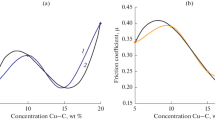Abstract
Features and peculiarities of structure formation for the friction zone in highly effective composite materials based on copper for prescribed experimental conditions (high contact loads and sliding rates, absence of a lubricant, operation in a high vacuum or in air) are considered. It is shown that reliable efficiency for a tribological system under friction conditions with action of high compressive forces and sliding rates is provided by material adaptation that is achieved via the tribological synthesis at the contact surfaces of a lubricating layer different in composition and structure from the original composite.
Similar content being viewed by others
References
I. M. Fedorchenko and L. I. Pugina, Composite Sintered Antifriction Materials [in Russian], Nauk. Dumka, Kiev (1980).
E. L. Shvedkov, I. I. Panaioti, O. I. Fushchich, and G. M. Derkacheva, “Friction and wear of friction material based on iron-phosphorus. II. Mechanism of a friction pair in a moderately loaded assembly,” Poroshk. Metall., No. 2, 67–70 (1976).
O. I. Fushchich and V. D. Zozulya, “Study of the surface composition of a friction pair with metal sliding bearings by spectral analysis,” Poroshk. Metall., No. 4, 61–64 (1971).
L. F. Kolesnichenko and P. V. Trushko, “Formation of boundary layers during friction in the presence of sulfur,” Poroshk. Metall., No. 12, 47–52 (1970).
A. S. Demyanchuk, V. D. Zozulya, and O. I. Fushchich, “Use of local spectral analysis in studying friction,” Zhurn. Prikl. Spektroskopii, 7, No. 4, 14–15 (1967).
A. G. Kostornov, T. M. Chevichelova, O. I. Fushchich, et al., Composite Antifriction Self-Lubricating Material Based on Copper, Pat. 73217 Ukrainian, Publ. June 15 (2005).
A. G. Kostornov, O. I. Fushchich, Y. M. Simeonova, and T. M. Chevichelova, “The influence of metallubricant on copper basis on the structure and tribological characteristics of composite antifriction material that works in a vacuum,” Proc. Internat. Conf. “Science for Materials in the Frontier of Centuries: Advantages and Challenges” (September 16–20, 2002, Katsiveli, Crimea), Institute for Problems of Materials Science, National Academy of Sciences of Ukraine, Kiev (2002), p. 549.
A. G. Kostornov, O. I. Fushchich, T. M. Chevichelova, and A. D. Kostenko, “The research of influence of temper elements on tribological properties of composite antifriction materials self-lubricating materials,” Proc. Internat. Conf. “Science for Materials in the Frontier of Centuries: Advantages and Challenges” (September 16–20, 2002, Katsiveli, Crimea), Institute for Problems of Materials Science, National Academy of Sciences of Ukraine, Kiev (2002), p. 72.
A. G. Kostornov, O. I. Fushchich, T. M. Chevichelova, et al., “New self-lubricating composite materials for friction assemblies in space technology,” in: Materials and Coatings under Extreme Conditions: Study, Application, Ecologically Clean Technology for Production and Utilization of Articles, Proc. Internat. Conf. (September 13–17, 2004, Katsiveli, Crimea), Akademperiodika, Kiev (2004), pp. 306–307.
A. Kostornov, A. Yuga, T. Chevichelova, et al., “Application of composite material “ IPM-301” at tribojunction of space radiometric system “R-400,” Proc. Second Internat. Conf. “Materials and Coatings for Extreme Performances: Investigations, Applications, Ecologically Safe Technologies for their Production and Utilization” (September 16–20, 2002, Katsiveli, Crimea), Institute for Problems of Materials Science, National Academy of Sciences of Ukraine, Kiev (2002), pp. 519–520.
N. Canter, “The search for copper-based self-lubricating composite,” Tribology Lubrication Technology, May, 12–14 (2004).
L. F. Kolesnichenko, A. I. Yuga, T. M. Chevichelova, et al., “Friction properties of composite materials with a macro-and microheterogeneous working surface,” Poroshk. Metall., No. 7, 78–83 (1986).
O. I. Fushchich, A. D. Panasyuk, L. F. Kolesnichenko, et al., “Effect of tin on the formation of an interphase boundary for antifriction composite copper-lead-tine alloy,” Adgeziya Rasplavov i Paika Materialov, No. 8, 41–45 (1981).
O. I. Fushchich, A. D. Panasyuk, L. F. Kolesnichenko, et al., “Interphase reaction of the structural components of antifriction composite materials based on copper,” Adgeziya Rasplavov i Paika Materialov, No. 13, 61–66 (1984).
L. F. Kolesnichenko, O. I. Fushchich, A. D. Panasyuk, et al., “Contact reaction of the structural components of antifriction composite material based on copper,” Poroshk. Metall., No. 4, 82–86 (1984).
Author information
Authors and Affiliations
Additional information
__________
Translated from Poroshkovaya Metallurgiya, Nos. 3–4(448), pp. 14–21, March–April, 2006.
Rights and permissions
About this article
Cite this article
Kostornov, A.G., Simeonova, Y.M., Fushchich, O.I. et al. Effect of factors governing dry friction on structure formation for the tribological synthesis zone in composites based on copper. Powder Metall Met Ceram 45, 118–123 (2006). https://doi.org/10.1007/s11106-006-0051-8
Received:
Issue Date:
DOI: https://doi.org/10.1007/s11106-006-0051-8




